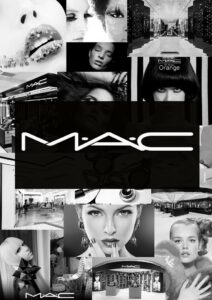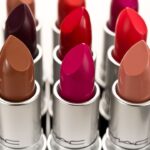The Evolution of MAC Cosmetics: From Backstage to Beauty Icon

Founded in 1984 in Toronto, Canada, MAC Cosmetics (Make-up Art Cosmetics) has grown from a niche brand for makeup artists into a global beauty phenomenon. Renowned for its vibrant colors, inclusive shade ranges, and innovative products, MAC has played a significant role in shaping the beauty industry over the past few decades. This blog post explores the rich history of MAC Cosmetics, from its humble beginnings to its current status as a beauty powerhouse.
The Birth of MAC: 1980s
The story of MAC Cosmetics began with Frank Toskan, a makeup artist and photographer, and Frank Angelo, a beauty salon owner. Frustrated by the lack of makeup that performed well under the intense lighting of photoshoots and offered a wide range of colors, the duo set out to create a brand that filled this gap. In 1984, they launched MAC Cosmetics, initially selling products directly to makeup artists, models, and photographers.
MAC’s first products were innovative and different from other brands available at the time. They introduced foundation in a broader range of colors to cater to all skin tones and developed highly pigmented, long-lasting products that stood out under the bright lights of photo studios and on fashion runways. The brand’s bold, professional-quality makeup quickly gained a loyal following in the beauty and fashion communities.
The Rise to Fame: 1990s
MAC Cosmetics’ reputation for high-quality products and vibrant colors soon spread beyond the fashion world. In the early 1990s, the brand began to gain popularity among everyday consumers, thanks in part to its distinctive packaging and the unique retail experience it offered. MAC was one of the first brands to encourage customers to try on products before purchasing them, creating a more interactive and personalized shopping experience.
In 1994, MAC launched its famous Viva Glam campaign with drag queen and performer RuPaul as the first spokesperson. The campaign aimed to raise awareness and funds for HIV/AIDS research, with 100% of the sales of Viva Glam lipsticks going to the MAC AIDS Fund. This bold move not only showcased MAC’s commitment to social causes but also positioned the brand as a pioneer in embracing diversity and inclusivity in the beauty industry.
Going Global: 2000s
In 1998, Estée Lauder Companies acquired MAC Cosmetics, providing the brand with the resources and infrastructure needed to expand globally. Under Estée Lauder’s ownership, MAC continued to grow, opening stores in major cities around the world and increasing its product offerings. The 2000s saw MAC collaborating with a range of celebrities, designers, and pop culture icons, creating limited-edition collections that drove consumer excitement and engagement.
MAC’s commitment to inclusivity remained a core part of its brand identity. The company continued to lead the way in offering a diverse range of shades for all skin tones, as well as promoting beauty without boundaries through its various advertising campaigns and product launches.
The Digital Age: 2010s to Present
As the beauty industry shifted towards digital platforms and social media, MAC adapted by expanding its online presence and engaging with beauty influencers and content creators. The brand leveraged social media to connect with younger audiences and launched several successful digital campaigns that emphasized its core values of diversity, creativity, and self-expression.
presence and engaging with beauty influencers and content creators. The brand leveraged social media to connect with younger audiences and launched several successful digital campaigns that emphasized its core values of diversity, creativity, and self-expression.
In recent years, MAC has continued to innovate, introducing new product lines and collaborating with emerging talent in the beauty and fashion industries. The brand has embraced sustainable practices, such as the Back-to-MAC program, which encourages customers to return empty product containers for recycling in exchange for a free lipstick. This initiative reflects MAC’s ongoing commitment to environmental responsibility.
FAQs:
- What is MAC’s best-selling product?MAC’s most iconic product is its lipstick line, particularly shades like Ruby Woo and Velvet Teddy.
- Is MAC cruelty-free?MAC does not test on animals except where required by law. However, the brand is not considered cruelty-free by all standards
- Does MAC offer vegan products?
-
- MAC offers some vegan products, but not all of their products are vegan. It’s best to check the ingredient list for each product.
-
- How many shades of foundation does MAC offer?
-
- MAC is known for its wide range of foundation shades, with many of their lines offering up to 60 shades to cater to all skin tones.
-
- What is the Back-to-MAC recycling program?
-
- Customers can return six empty MAC containers in exchange for a free lipstick of their choice. The program promotes recycling and sustainability.
-
- What is the Viva Glam campaign?
-
- Viva Glam is a charity initiative by MAC where 100% of proceeds from specific lipstick sales are donated to support those affected by HIV/AIDS.
-
- Can I return MAC products if they don’t match my skin tone?
-
- Yes, MAC offers returns and exchanges on products that don’t match, but the policy can vary by location and store.
-
- How do I find the right foundation shade in MAC?
-
- You can visit a MAC store for a shade match by a professional artist, or use MAC’s online shade-matching tool.
-
- What’s the difference between MAC’s Studio Fix Fluid and Face and Body Foundation?
-
- Studio Fix Fluid is a full-coverage, matte foundation, while Face and Body Foundation is lightweight and gives a more natural, dewy finish.
-
- Does MAC offer professional discounts for makeup artists?
- Yes, MAC has the MAC Pro program, which offers professional makeup artists discounts and access to exclusive products.
Conclusion
From its beginnings as a niche brand for makeup artists to becoming a global beauty icon, MAC Cosmetics has consistently pushed the boundaries of the beauty industry. Its commitment to inclusivity, innovation, and social causes has set it apart from other brands and earned it a loyal following around the world. As MAC continues to evolve in the digital age, it remains true to its mission of celebrating individuality and empowering people to express themselves through the art of makeup.



